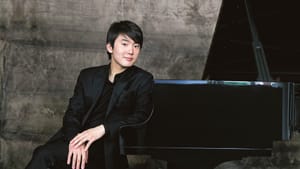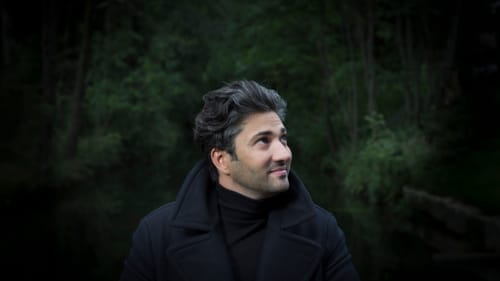Stay in the Loop
BSR publishes on a weekly schedule, with an email newsletter every Wednesday and Thursday morning. There’s no paywall, and subscribing is always free.
Igniting the classics
Philadelphia Orchestra presents Brahms and Mozart with David Afkham and Seong-Jin Cho

I am still reeling from the Philadelphia Orchestra's revelatory performance of Brahms's First Symphony. This beloved but sometimes stuffy work has been a favorite of the classical repertoire for more than 150 years, and frankly, I have heard it a few times too many. But never like this.
David Afkham, German-born conductor of the Spanish National Orchestra and Chorus, led the orchestra in such a dazzling performance I felt as though I never heard the First before. Gone was all pomposity. Instead, the structure of Brahms's careful writing shone clear and bright, like a crystal scaffold embracing and releasing music of almost unbearable intensity.
Where has this music been hiding? Afkham, who resembled a handsome young magician as he coaxed the symphony's soul out of the orchestra, had the key and was not afraid to use it.
Unlike any other
From the spine-tingling opening, ominously heralded by Don Liuzzi on timpani, to its mind-blowing finale with an unforgettable brass choir, this was a Brahms First unlike any other. The first movement’s clarinet and horns sang sweetly to each other; then the cellos and basses swelled and rolled like waves in a storm-swept sea.
Afkham led forcefully, baton in hand, for three movements. In the tender second movement, he put the baton aside and molded the sound with expressive hands. Peter Smith's elegaic oboe and Ricardo Morales's mellow clarinet added brightness to the reverie of the orchestra's inimitable string section. Concertmaster David Kim's solo violin passages offered exactly the right racy pitch as the movement whispered to a close.
The final movement's commanding opening pulled back dramatically and spread out in a shower of pizzicato strings before the unfortunately insipid main theme enters. Brahms's musical ideas in the last movement remind us of the finale to Beethoven's Ninth, but as a tribute, not an attempt to equal or surpass that work.
When the final brass choir emerged, cutting through the tumble of orchestral resources like the sword of some hero-saint, I know I was not the only listener moved to tears. Brahms is so successful as a philosophical composer of profound thoughts that I think we shortchange him as a passionate romantic. When done right, without excess or laxity, that romanticism deserves to be heard, felt, and savored.
Piano mastery
While the Brahms, as the last work on the program, is fresher in my mind, the orchestra's performance of Mozart's Piano Concerto No. 20 in D minor was no less remarkable. Seong-Jin Cho, one of the most acclaimed young pianists on the international stage, lived up to his reputation. Reserved, with a K-pop idol’s looks and style, Cho gave not only a flawless performance of this complex concerto but infused each passage with intense feeling within the controlled environment of the classical tradition.

Conducting without a baton, Afkham led the orchestra in a sensitive balance of satisfying form and inspirational fervor. The beginning of this concerto often sounds a bit choppy to me, but perhaps the intent is to make the flowing melodies that follow all the more conspicuous for their loveliness and grace.
Cho's performance was a case study in piano mastery. His touch was certain, unwavering, with exactly the right pressure. The piano was never overwhelmed by the orchestra, nor did Cho try to force it or upstage anyone. Each phrase was clearly articulated, and fit the whole like pieces in a finely chiseled jigsaw puzzle. Yet, there was also a sense of the deep pools of feeling that nourish Mozart’s final works.
The orchestra and soloist together soared through the twists and turns from minor to major, back and forth, throughout the final movement. They followed the oboe and bassoon back into a final statement in the major mode, ending light as a butterfly on the final chord.
Not Shakespeare
The concert began with Beethoven's arresting Coriolan Overture. The work begins with three forceful chords, repeated several times within the overture, each time crumbling a bit more, or sobbing, like the end of the funeral march in the “Eroica” symphony.
Coriolan was a Roman general condemned by his people and taken in by the enemy. He attempts to take revenge, is persuaded to show mercy, and commits suicide.
The overture is not based on Shakespeare’s Coriolanus. At least one contemporary, composer Johann Friedrich Reichardt, thought Beethoven was portraying himself in the musical setting. Beethoven composed the overture in 1807 when he was 36, deaf and increasingly isolated from friends and society.
Afkham's interpretation of the stormy composition highlighted Beethoven's striking use of silence as a musical element. The charismatic conductor brought the short work to a close with a soft whisper of sound, as though the world really does, as poet T.S. Eliot suggested, end not with a bang but a whimper.
What, When, Where
Brahms and Mozart. Seong-Jin Cho, piano; David Afkham, conductor. Coriolan Overture, Op. 62, by Beethoven; Piano Concerto No. 20 in D minor, K. 466, by Mozart; Symphony No. 1 in C minor, Op. 68., by Brahms. November 1-3, 2018, at the Kimmel Center's Verizon Hall, 300 S. Broad Street, Philadelphia. (215) 893-1999 or philorch.org.
Sign up for our newsletter
All of the week's new articles, all in one place. Sign up for the free weekly BSR newsletters, and don't miss a conversation.

 Linda Holt
Linda Holt